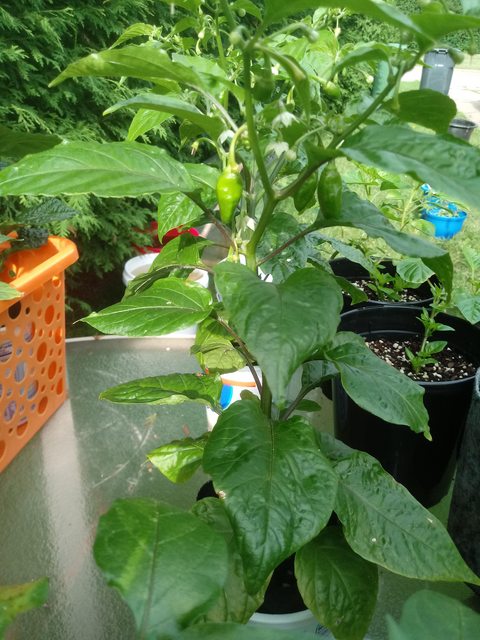-
Do you need help identifying a 🌶?
Is your plant suffering from an unknown issue? 🤧
Then ask in Identification and Diagnosis.
You are using an out of date browser. It may not display this or other websites correctly.
You should upgrade or use an alternative browser.
You should upgrade or use an alternative browser.
Super Hot Mystery
- Thread starter CraftyFox
- Start date
Does it? It is probably a hybrid, so it is not a documented pepper which people are able to identify.willard3 said:This should be posted in "Pepper ID"
SpeakPolish said:Does it? It is probably a hybrid, so it is not a documented pepper which people are able to identify.
I'm trying to figure out a nice way to explain to an 18 year old how to respect those that have more years growing & studying hot peppers than he's been alive. OK, I'll do this NICE this time.
obviously you don't know that even hybrids will have characteristics that can help ID the genetics of pepper species.
obviously you don't know that flowers can help ID species.
obviously you don't know that leaf characteristics can help ID species.
obviously you don't know that fruit per node can help ID species..
obviously you don't know that a constricted calyx can help ID species.
obviously you don't know that plant growth characteristics can help ID species.
obviously you don't know that fruit phenotype can help ID species.
So exactly what do you know with your vast experience growing and studying hot peppers for a few years? (Willard & I have over 50 years combined.)

Yea, that's what I thought.
And that's the last time I'll be nice in my responses to your ignorance.
The_NorthEast_ChileMan said:
I'm trying to figure out a nice way to explain to an 18 year old how to respect those that have more years growing & studying hot peppers than he's been alive. OK, I'll do this NICE this time.
obviously you don't know that even hybrids will have characteristics that can help ID the genetics of pepper species.
obviously you don't know that flowers can help ID species.
obviously you don't know that leaf characteristics can help ID species.
obviously you don't know that fruit per node can help ID species..
obviously you don't know that a constricted calyx can help ID species.
obviously you don't know that plant growth characteristics can help ID species.
obviously you don't know that fruit phenotype can help ID species.
So exactly what do you know with your vast experience growing and studying hot peppers for a few years? (Willard & I have over 50 years combined.)

Yea, that's what I thought.
And that's the last time I'll be nice in my responses to your ignorance.
You and willard are a couple of jerk off's...lol
If we're talking about the *species, I feel pretty sure that's Capsicum chinense in the OP.
Guessing which exact cultivars are involved in the cross might be a bit harder to do.
I haven't been growing peppers for all that long, but I've been playing around on internet forums for ages. When daily post counts are a low as they are these days, it may not be very helpful for users to police one another about using the wrong sub-forum or conducting a thorough search before posting.
To me, it seems best to help out if you can and just keep the discussion going. That's just my opinion, but I think we can all agree that it's more fun to talk about chiles rather than talking about forum etiquette.
Guessing which exact cultivars are involved in the cross might be a bit harder to do.
I haven't been growing peppers for all that long, but I've been playing around on internet forums for ages. When daily post counts are a low as they are these days, it may not be very helpful for users to police one another about using the wrong sub-forum or conducting a thorough search before posting.
To me, it seems best to help out if you can and just keep the discussion going. That's just my opinion, but I think we can all agree that it's more fun to talk about chiles rather than talking about forum etiquette.
I was just debating semantics. Also using experience is not an excuse. There is something called the internet, and it helps way more than decades of growing. I now have the knowledge of millions of years of growing.The_NorthEast_ChileMan said:
I'm trying to figure out a nice way to explain to an 18 year old how to respect those that have more years growing & studying hot peppers than he's been alive. OK, I'll do this NICE this time.
obviously you don't know that even hybrids will have characteristics that can help ID the genetics of pepper species.
obviously you don't know that flowers can help ID species.
obviously you don't know that leaf characteristics can help ID species.
obviously you don't know that fruit per node can help ID species..
obviously you don't know that a constricted calyx can help ID species.
obviously you don't know that plant growth characteristics can help ID species.
obviously you don't know that fruit phenotype can help ID species.
So exactly what do you know with your vast experience growing and studying hot peppers for a few years? (Willard & I have over 50 years combined.)

Yea, that's what I thought.
And that's the last time I'll be nice in my responses to your ignorance.
In any website that has instruction for pepper ids, they almost all have those descriptions.
I searched google for (How to identify pepper species). Here is the first result. It has everything that you just described. https://www.ehow.com/how_5625187_identify-pepper-plants.html
Wowzers!!
I actually did think about posting this to the ID forum, but identification wasn't my first thought in posting this.. I wasn't sure it could be "Id'd". Not that I'd have any objections to it being moved to the ID forum. I can certainly see the merits in having it there. I actually posted it here because I thought posting it there could create a potential conflict..
Go figure.
I will say that the only variegated pepper I had last year was a 'Candy Cane', which is Annuum.
These seeds definitely came from a Carolina Reaper, a Bhut, or a Butch T, none of which had blunt ends like some of these pods.
I've kind of ruled out Butch T in my mind because the pod remains were wrinkled heavily.
I'm stuck on Bhut x Candy Cane, which seems unlikely.. Given they were on the opposite side of the area from each other.
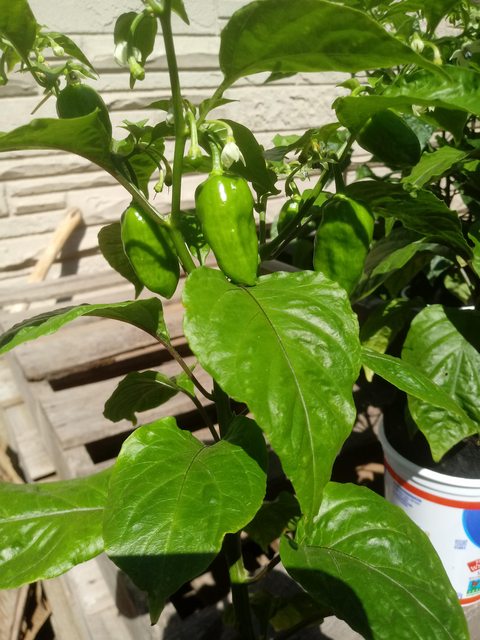
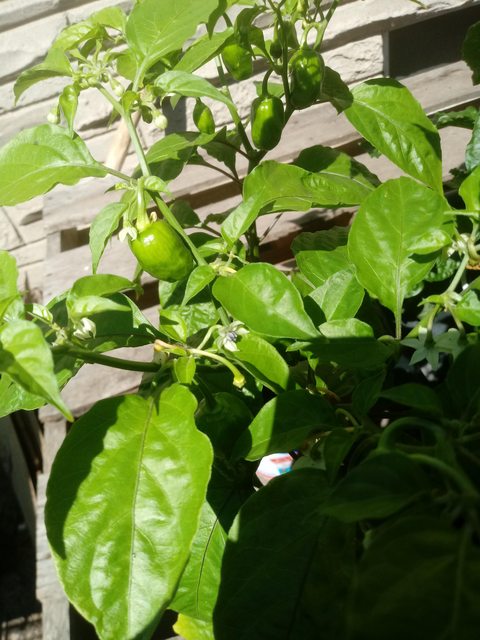
I actually did think about posting this to the ID forum, but identification wasn't my first thought in posting this.. I wasn't sure it could be "Id'd". Not that I'd have any objections to it being moved to the ID forum. I can certainly see the merits in having it there. I actually posted it here because I thought posting it there could create a potential conflict..
Go figure.
I will say that the only variegated pepper I had last year was a 'Candy Cane', which is Annuum.
These seeds definitely came from a Carolina Reaper, a Bhut, or a Butch T, none of which had blunt ends like some of these pods.
I've kind of ruled out Butch T in my mind because the pod remains were wrinkled heavily.
I'm stuck on Bhut x Candy Cane, which seems unlikely.. Given they were on the opposite side of the area from each other.


CaneDog said:My input would be that I see some ruffled leaf edges which is so common on bhuts.
The second most accurate comment in this thread,right behind the one posted by FreeportBum. Definitely see some Indian genes in those leaves.
SpeakPolish said:I was just debating semantics. Also using experience is not an excuse. There is something called the internet, and it helps way more than decades of growing. I now have the knowledge of millions of years of growing.
If it smells like poop and looks like poop, it's poop
Unless you got some real bad chocolatewillard3 said:
If it smells like poop and looks like poop, it's poop
The pods look very smooth compared to the super hots you have listed in the original post.
Did you have any varieties of C. Chinense last year with smooth pods?
Did you have any varieties of C. Chinense last year with smooth pods?
You do realize that if you follow that link, and then trace the information back a step, you end up right at Paul's door, right?SpeakPolish said:I was just debating semantics. Also using experience is not an excuse. There is something called the internet, and it helps way more than decades of growing. I now have the knowledge of millions of years of growing.
In any website that has instruction for pepper ids, they almost all have those descriptions.
I searched google for (How to identify pepper species). Here is the first result. It has everything that you just described. https://www.ehow.com/how_5625187_identify-pepper-plants.html
I know that you are, at least in part, responsible for helping get that Capsicum key out there, even though it seems to be dated and in need of refinement. Still appreciate it and look forward to understanding the relation of pedicels soon. Any links you could toss me related to understanding that? Or perhaps a link to a more inclusive key? I'm more interested in the pedicels though, as the key becomes kinda broken without a solid understanding. Kinda surprised there isn't a good thread on here about it.. Or am I missing it?The_NorthEast_ChileMan said:
So exactly what do you know with your vast experience growing and studying hot peppers for a few years? (Willard & I have over 50 years combined.)
I thought that was odd too, as I recall the Bhuts being wrinkled from the start..MisterBigglesworth said:The pods look very smooth compared to the super hots you have listed in the original post. Did you have any varieties of C. Chinense last year with smooth pods?
I had some Orange Habs, but they weren't the mother of these, because the pod remains I gathered the seed from was red and wrinkled. The Candy Cane variety I suspect being the cross was a smooth type with an elongated block bell style and variegation, similar to some of the pods these are throwing. 2 of my other ones have started setting pods now so it'll be interesting to see what shapes dominate those, and if the variegation actually holds out. Then I've got another plant in a bigger pot that is just starting to bud out..
Given the lack of tail, I can't believe these came from the Reaper or the Butch T.. The tips on a good chuck of them, as well as the shape, are very reminiscent of the Bhuts I had last year. Butch T Trinidads were actually really smooth though.
This is the total list, if I can recall correct.
Supers: Carolina Reaper, Trinidad "Butch T", Red Bhut
Hots: Orange Hab, African Devil
Annuum: Cajun Belle, Candy Cane x 2
If you think you collected the seeds for these from a SuperHot pod, but you were growing around variegated annuums and standard Orange Habs, it's possible that it crossed with one of those smooth-azz emmer-effers, and it's likely that would be enough to cause the progeny to have the smooth appearance.
I'm not trying to be a jerk; I use THP on a little shitty phone, so I can't see pictures very well, but is the plant from the OP variegated at all?
I'm not trying to be a jerk; I use THP on a little shitty phone, so I can't see pictures very well, but is the plant from the OP variegated at all?
It has some pin stripes for sure, both plants.. Don't see those on any of my other plant's pods. Or maybe I'm just seeing things.. Anyone else see it?Bicycle808 said:If you think you collected the seeds for these from a SuperHot pod, but you were growing around variegated annuums and standard Orange Habs, it's possible that it crossed with one of those smooth-azz emmer-effers, and it's likely that would be enough to cause the progeny to have the smooth appearance.
I'm not trying to be a jerk; I use THP on a little shitty phone, so I can't see pictures very well, but is the plant from the OP variegated at all?
Exactly. Paul said I did not know those stuff. And I proved him wrong with a single Google search.CraftyFox said:You do realize that if you follow that link, and then trace the information back a step, you end up right at Paul's door, right?
I know that you are, at least in part, responsible for helping get that Capsicum key out there, even though it seems to be dated and in need of refinement. Still appreciate it and look forward to understanding the relation of pedicels soon. Any links you could toss me related to understanding that? Or perhaps a link to a more inclusive key? I'm more interested in the pedicels though, as the key becomes kinda broken without a solid understanding. Kinda surprised there isn't a good thread on here about it.. Or am I missing it?
I thought that was odd too, as I recall the Bhuts being wrinkled from the start..
I had some Orange Habs, but they weren't the mother of these, because the pod remains I gathered the seed from was red and wrinkled. The Candy Cane variety I suspect being the cross was a smooth type with an elongated block bell style and variegation, similar to some of the pods these are throwing. 2 of my other ones have started setting pods now so it'll be interesting to see what shapes dominate those, and if the variegation actually holds out. Then I've got another plant in a bigger pot that is just starting to bud out..
Given the lack of tail, I can't believe these came from the Reaper or the Butch T.. The tips on a good chuck of them, as well as the shape, are very reminiscent of the Bhuts I had last year. Butch T Trinidads were actually really smooth though.
This is the total list, if I can recall correct.
Supers: Carolina Reaper, Trinidad "Butch T", Red Bhut
Hots: Orange Hab, African Devil
Annuum: Cajun Belle, Candy Cane x 2
So, I harvested a bunch of them a few days after they turned orange.. Sure look like Habs to me. They are a bit bigger than the Habs I had last year, and sweeter. Sweeter than most of the Habs I've had so far, with almost a bell pepper sweetness under the chinense one.. Also fairly hot, but I'd put it on the lower end of the typical store Hab heat. Super Hot, they are not 
The variegation was likely a fluke because it's all gone now. I want to say these were some of the last peppers I started this year too, which would make them pretty fast to ripen.. Even the one in the 3 gallon bag is starting to color up.
I'm trying hard to see if these ripen to red.. They are just so dang tasty!!
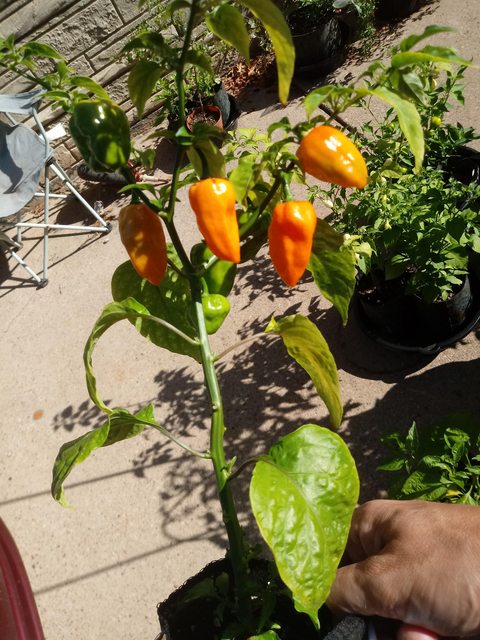
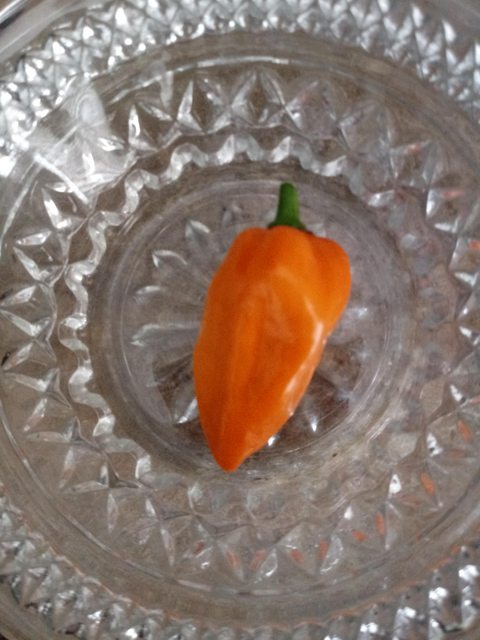
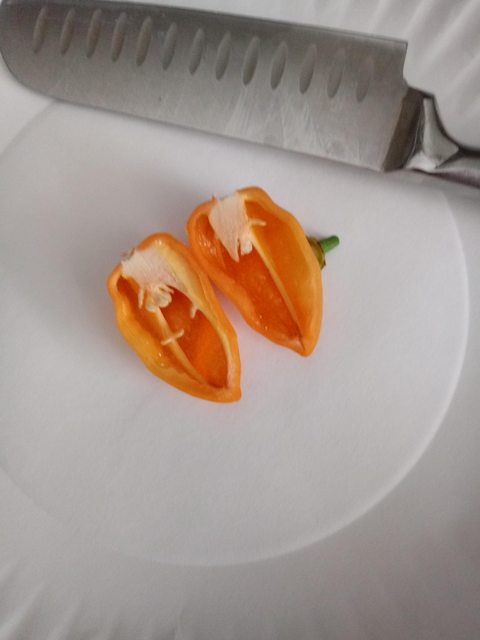
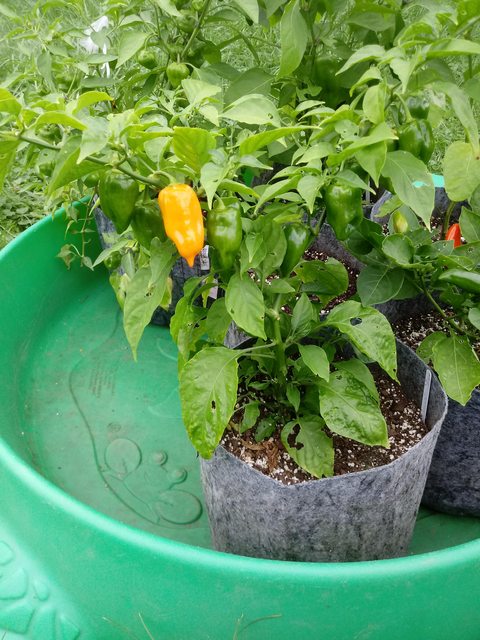

The variegation was likely a fluke because it's all gone now. I want to say these were some of the last peppers I started this year too, which would make them pretty fast to ripen.. Even the one in the 3 gallon bag is starting to color up.
I'm trying hard to see if these ripen to red.. They are just so dang tasty!!





